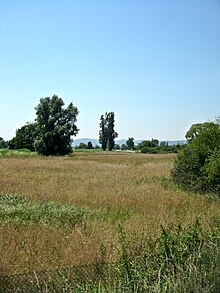Käskönig
The Käskönig was a person of historical customs in Bad Dürkheim in the Upper Palatinate and referred to grazing rights in the Dürkheimer Bruch .
history
The Dürkheimer Bruch is a meadow and heather landscape that follows the course of the Isenachbach , from the eastern outskirts of Bad Dürkheim to the Eyersheimer Hof in the Weisenheim am Sand district . From ancient times it was used as a pasture for cattle; In more recent times, agriculture has also been practiced there, and a part near Bad Dürkheim is now built on with an industrial area.
According to Johann Georg Lehmann , the Dürkheimer Bruch belonged to the Salian foundation of the Limburg Monastery in 1035 . Its abbot granted the community of Dürkheim the exercise of grazing rights there very early on . Dürkheim also allowed neighboring villages and farms to participate in these rights for a fee.
Every year on Whit Monday a representative rode around to collect the taxes due. As they mostly consisted of cheese in addition to money, the collector was also referred to as the “cheese king” . Gradually, therefore, a real folk custom developed. The historian Michael Frey describes it as follows:
“ A king chosen from the citizens' sons and his marshal, accompanied by two afters (additional council body) and a strong retinue, drove around every year in the morning of Whit Monday to the villages and farms that were also entitled to graze to receive the fixed grazing interest , which consisted largely of cheese and gave him the honorary title of cheese king. In the afternoon the procession was completed and the grandiose king made his entry into the city of Dürkheim - on his head a crown of blue cornflowers and in his hand as a scepter a staff with a crowned cheese attached. A “queen”, chosen from Dürkheim's virgins, and a companion for the marshal, waited for him on the upper market. The vigilante guard then closed a circle around the two lovely couples who began the dance of honor with their companions. Whereupon the whole swarm streamed towards the "kingdom", an inn designated for this and freed from all taxes for three days, for dancing and feasting. "
This Käskönig custom existed until the end of the 18th century and Michael Frey also notes that, for example, the miller at the Eyersheimer Mühle had to pay 15 Albus and one cheese as an individual tax. The owner of the Eyersheimer Hof , to which the obligations of the lost village of Eyersheim had been transferred, had to pay 15 Albus and 32 cheeses.
The Lambsheim poet Karl Geib writes in his “travel guide through all parts of the royal Bavarian Rhine Palatinate” that the Eyersheimer Hof was the end of the traditional Käskönig ride, where a “rural pleasure” took place before the Käskönig returned to Bad Dürkheim.
In the "Bavaria - Landes- und Volkskunde des Kingdom of Bavaria" it is said in 1867 that the procession to the Eyersheimer Hof took place with a "sounding game" (with a music band) and that there was also partying into the night. The Käskönig and his companions wore “fantastic clothes”.
Because of the fact that the Palatinate belonged to Bavaria at the time, the story of the Käskönig was also included in the “Sagenbuch der Bayerischen Lande” published by Alexander Schöppner in 1853 (Volume 1, pp. 322–323).
In memory of the historical custom, there is currently the annual Käskönigfest in Bad Dürkheim .
literature
- August Becker : The Palatinate and the Palatinate , Leipzig, 1858, p. 222 u. 223, (digital scan)
- Liselotte Stoll: Publications of the Palatinate Society for the Promotion of Science in Speyer am Rhein , Volume 51, 1966, p. 63; (Detail scan)
- Helmut Seebach: What the Palatinate farmer does not know - Eating and drinking through the ages : a contribution to the folklore of the Palatinate , 1991, p. 144, ISBN 3924115087 ; (Detail scan)
Individual evidence
- ^ Johann Georg Lehmann : Historical paintings from the Rhine district of Bavaria , Volume 2, Heidelberg, 1834, p. 130 u. 131; (Digital scan)
- ↑ Website with description of the eighth position
- ^ Karl Geib: travel guide through all parts of the royal Bavarian Rhine Palatinate , Zweibrücken, 1841, p. 116; (Digital scan)
- ^ Bavaria - Landes- und Volkskunde des Kingdom of Bavaria , Volume 4, Munich, 1867, p. 400; (Digital scan)
- ↑ https://reader.digitale-sammlungen.de/de/fs1/object/display/bsb10386435_00342.html
- ↑ To the Käskönigfest

